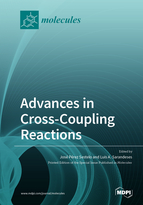Advances in Cross-Coupling Reactions
A special issue of Molecules (ISSN 1420-3049). This special issue belongs to the section "Organic Chemistry".
Deadline for manuscript submissions: closed (30 June 2020) | Viewed by 59263
Special Issue Editors
Interests: cross-coupling reactions; metal-catalysis; indium chemistry; natural product synthesis
Interests: transition metals in organic synthesis (especially cross-coupling reactions); indium in organic synthesis, and in the synthesis of natural products and pharmacologically active compounds
Special Issue Information
Dear Colleagues,
Nowadays, metal-catalyzed cross-coupling reactions are recognized as a fundamental synthetic tool for the preparation of a wide variety of organic compounds, from bioactive molecules to new organic materials. The most significant features of this methodology relay in the versatility to build most of the carbon–carbon type bonds, particularly between unsaturated carbons, and carbon-heteroatom bonds using heteronucleophiles. On the other hand, a variety of organic electrophiles can participate and the reactivity can be tuned by using the adequate catalyst. As a consequence, this methodology has been applied to industrial processes under classical and non-classical reaction conditions. Despite these attractive synthetic properties, continuous advances in order to improve the selectivity, efficiency and sustainability of the coupling reactions are being reported.
This Special Issue is launched with the purpose to highlight the most recent significant advances of cross-coupling reactions. Novel aspects in this issue will cover new leaving groups, nucleophiles, catalysts, and non-classical reaction conditions. We hope that this special issue stimulates authors and readers, so much as the Editors.
Prof. José Pérez Sestelo
Prof. Luis A. Sarandeses
Guest Editors
Manuscript Submission Information
Manuscripts should be submitted online at www.mdpi.com by registering and logging in to this website. Once you are registered, click here to go to the submission form. Manuscripts can be submitted until the deadline. All submissions that pass pre-check are peer-reviewed. Accepted papers will be published continuously in the journal (as soon as accepted) and will be listed together on the special issue website. Research articles, review articles as well as short communications are invited. For planned papers, a title and short abstract (about 100 words) can be sent to the Editorial Office for announcement on this website.
Submitted manuscripts should not have been published previously, nor be under consideration for publication elsewhere (except conference proceedings papers). All manuscripts are thoroughly refereed through a single-blind peer-review process. A guide for authors and other relevant information for submission of manuscripts is available on the Instructions for Authors page. Molecules is an international peer-reviewed open access semimonthly journal published by MDPI.
Please visit the Instructions for Authors page before submitting a manuscript. The Article Processing Charge (APC) for publication in this open access journal is 2700 CHF (Swiss Francs). Submitted papers should be well formatted and use good English. Authors may use MDPI's English editing service prior to publication or during author revisions.
Keywords
- Cross-coupling reactions
- Metal-catalyzed reactions
- C–C bond forming reaction
- C–Heteroatom bond forming reactions
- Palladium
- Nickel
- Organoboron compounds
- Main-group organometallics








